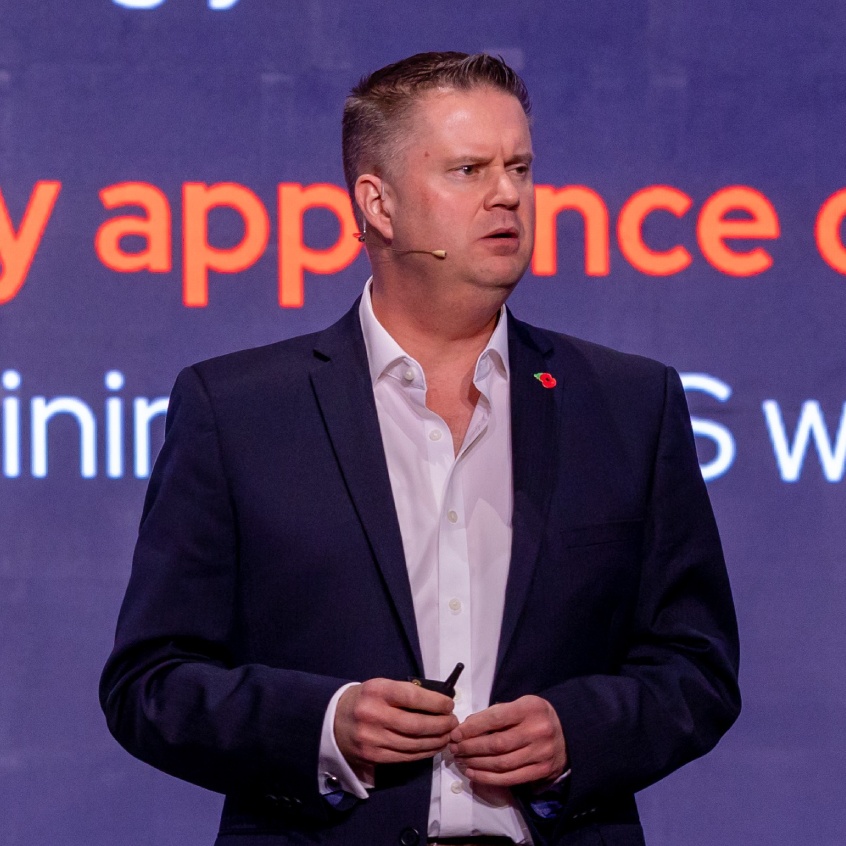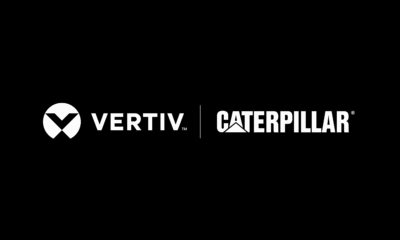Tech Interviews
RedHat Summit Connect 2025: A discussion with Ed Hoppitt and Adrian Pickering

Exclusive Interview with Ed Hoppitt, EMEA Director – Value Strategy, App and Cloud Platforms at Red Hat & Adrian Pickering, Regional General Manager, MENA & Enterprise Segment Lead for CEMEA at Red Hat
Having worked in global telecom and advised some of the world’s largest enterprises, how have these experiences shaped your approach to developing IT solutions?
Ed: I believe that designing and running operational IT over many years gives one a deep understanding of what truly matters to a customer, especially those partnering with Red Hat. This background enables me to connect with our customers on a level where they feel understood regarding their pain points. Today’s biggest challenge for enterprise IT is building systems that are predictable, replicable, and standardized—yet able to scale effectively.
When you look at what Red Hat offers and how we help enterprises build these solutions, our focus is rooted in leveraging the open source community. We invest in projects that we know will create tremendous value for our enterprise customers, taking those projects upstream, incorporating them into the Red Hat portfolio, and industrializing them into platforms such as OpenShift. Customers choose platforms like OpenShift because they represent best-of-breed choices, delivering stability, reliability, predictability, and scalability. With my operational IT background, I appreciate just how crucial these outcomes are for every customer I speak with.
This year’s Red Hat Summit focuses on curiosity and turning acquired knowledge into practical application. It’s about transforming acquired knowledge into practical applications. Through this, what key message are you hoping to leave with the audience this year?
Adrian: I view curiosity as the foundation for working with our customers to truly understand their vision—where they want to be 18, 24, 30, or even 36 months down the line. It’s about gaining a clear grasp of the business challenges they face or the new markets they wish to serve in the future. We then align our best capabilities to support them along that journey, keeping cost efficiency in mind. This might involve modernizing infrastructure, existing applications, or even building new applications that open doors to entirely new customer segments or solutions.
A great example of this is our work with the Dubai Health Authority, who were on stage at Summit Connect Dubai. When we engaged with them, we took the time to deeply understand the challenges they were trying to address for the citizens and then brought not only our technical products but also our expertise in project management, implementation, training, and knowledge transfer. I’m very proud of our achievements over the years, and I believe that in doing so, we add significant value for our customers.
Ed: To add another perspective, the most compelling conversations I have with customers often begin with discussions that don’t initially center on technology. They start with, “I want to imagine a world where things are different—where you can help me achieve something extraordinary.” For instance, with Red Hat OpenShift AI, we collaborated with the US Department of Veterans Affairs to build a platform that effectively reduced self-harm and suicide rates. By harnessing a platform that could analyze how people called in for assistance—assessing tone and how they described their situations—we helped the teams prioritize who needed immediate care versus who could wait a while for some support.
It’s when someone presents you with such a profound challenge that you really see the immense opportunity we have as an organization. These technology platforms do more than enable business; they help vulnerable people receive the care they need and, ultimately, save lives.
You mentioned that for Red Hat it’s relatively easy to work on new technologies because of the robust support provided by partners and customers alike. Can you elaborate on just how important those relationships are for your team?
Adrian: The point is that, while we are proud of the solutions we deliver through Red Hat, many integrated solutions require components from multiple software vendors. Our partners and integrators are essential because they bring together the various components needed to deliver, implement, and support these complex solutions. In many regions, especially where we serve multiple countries, these partners offer additional scale and reach, often accessing markets where Red Hat might not have a direct footprint. This collaboration is a critical part of why we work so closely with our partners.
Ed: Another significant benefit of having partners is that it allows Red Hat to concentrate on what we do best. We aren’t trying to solve every aspect of the IT enterprise supply chain. Instead, we work with best-of-breed partners who focus on their own areas of expertise. This means that Adrian’s teams and others in our region can focus on delivering core value to our customers. As we saw on stage, one of the Middle East’s largest banking group was very ahead of the curve in its approach to virtualisation and modernisation. These partners enable us to help customers execute at scale and with credibility. My background in operational IT tells me that although the journey is rarely smooth, having a trusted team and partners makes all the difference.
In today’s enterprise technology landscape, where hybrid and multi-cloud environments are the norm, how is Red Hat helping customers unlock the potential of open source technologies?
Ed: For me, the hybrid and multi-cloud narrative is essentially about providing customers with standardization. Some customers might say that they’re on a path toward data center consolidation, or are committed to a single hypervisor, or even a multi-cloud strategy. But once they embrace a hybrid approach, the underlying message is that they require a globally consistent management and operational platform—one that spans multiple cloud providers, private data centers, or even edge environments.
How do we achieve this consistency in an open source manner? When you’re a proprietary company, control is tight. With our strategy, we offer customers open choice—where to run their platform and which workloads to deploy on top of it. In essence, our approach empowers customers by eliminating the risks of siloed, locked-in solutions. This freedom enables businesses to continuously ask, “What should I run, and where and how should I run it?” They consider the portfolio of applications, evaluate whether low-latency edge deployment is needed—as is common for a supermarket loyalty system—or whether a core data center or public cloud deployment makes sense. The operational “how” is addressed by determining whether to run on a container platform, a virtual machine platform, or an alternative setup. Finally, the “why” ties back to ensuring the overall solution aligns with the customer’s cost and business objectives.
Ultimately, our focus is on answering one simple question for the customer: “What should I run, and where, how, and why should I run it?” This encapsulates our commitment to providing both choice and clarity in today’s complex IT environment.
Adrian: I find it quite interesting how that perspective plays out regionally. While we enable customers to run applications on our platforms, major players like Google are also part of the ecosystem. Particularly in Europe, where there is current uncertainty, many governments are questioning whether their sovereign data should reside on a cloud service originating from the U.S. Without diving too deeply into politics, this debate is prompting customers to consider alternative cloud options. For example, when running OpenShift on-premises or on a cloud provided by a specific country, it becomes easier to migrate to a new provider if necessary. This is an evolving discussion, especially in Europe, and it’s something that might expand beyond political cycles in the future.
Ed: Exactly. In Europe, the focus remains on providing choice. With open source technology, we sidestep many political concerns because of the transparency it offers. Customers can inspect the code to see that there are no hidden backdoors or data issues. Consequently, building a sovereign solution using Red Hat technology has gained significant traction. Both governments and organizations are increasingly interested in retaining full control over their data.
It seems that customers also desire a degree of freedom with their platforms; they want to ensure that no external party completely controls their systems. How does Red Hat provide this assurance of complete control?
Ed: Customers can deploy our platform in either of two ways. If they run it in their own data center, on-premises. In this case, they obtain full access—they have the code, the platform, all the necessary certificates, and they manage it themselves. In contrast, if they decide to run the platform on one of the hyperscalers, while the underlying compute infrastructure is provided by the hyperscaler, the platform—the layer where the data sits and the applications operate—remains in the open source domain. Therefore, even in these cases, customers retain the ability to influence, control, and understand what happens with their data and applications. And when it comes down to it, every country and organization will make its own decisions, but our consistent message remains: our focus is on choice. Whether a company decides to run its workloads privately, on the public cloud, or at the edge, we ensure that they have the consistent tools and platforms to do so efficiently.
Adrian: That’s exactly right. We have long maintained a commitment to enabling customers to choose the open hybrid cloud. Whether a customer opts for a sovereign cloud, a hyperscaler, or their own private cloud, our core mission is to grant them the freedom to choose and to operate in a simple, consistent, and controlled manner.
Where do you see the enterprise technology landscape heading in the next three to five years?
Ed: I believe that over the next three to five years, we will witness an increasingly consolidated effort to eliminate complexity within IT organizations. Over the last decade, IT has excelled in building silos—if anything, it’s been very effective at doing so. However, with the advent of AI, these separate silos of infrastructure and data are becoming even more problematic. When your data resides in multiple unconnected silos, it becomes extremely challenging to aggregate and leverage it for AI-based insights.
In a recent discussion with a financial services industry leader, the focus was increasingly on ensuring access to all their data, democratizing it internally, and enabling AI-driven querying. This represents a paradigm shift, as data today typically lives within isolated applications. In an AI-integrated world, breaking down these silos is critical. I foresee that one of the most significant developments in the near future—driven by AI—will be the democratization of data access across organizations.
Adrian: I concur. From a regional perspective, we might be a couple of years behind more developed markets like Europe or the U.S. For instance, we are still in the earlier stages of transitioning to the cloud. In the UAE and other regions, sovereign cloud providers are just beginning to expand their offerings. Financial institutions, aviation companies, and others are now starting to embrace the cloud more aggressively than they have in the past four or five years.
Ed: Another nuance here involves what we’re exploring with Granite and small language models. Often, to help Adrian’s customers manage support tickets, you don’t need a language model that knows Shakespeare by heart. Large language models typically contain vast amounts of data, much of which isn’t directly relevant to a given enterprise. Our focus has thus shifted to a choice: do we help organizations harness AI by asking questions of data they couldn’t access before, or do we tailor solutions with smaller language models designed to address specific enterprise challenges?
One notable example was how we applied a tailored small language model within Red Hat to support our own teams in resolving support tickets. This initiative not only saved millions of dollars but also significantly enhanced customer experience and sped up response times. Over time, while large language models have captured much of the buzz, I suspect we will see rapid adoption of small, specialized language models tailored for specific functions.
Tech Interviews
Value Strategy, App and Cloud Platforms: Exclusive Interview with Ed Hoppit, EMEA Director, Red Hat


- How is Red Hat aligning its technology strategy with Saudi Arabia’s Vision 2030 and the country’s push toward large-scale digital transformation?
Red Hat’s approach enables businesses to innovate freely, operate securely, and accelerate their digital transformation, all of which align with Saudi Arabia’s Vision 2030. Our emphasis on open-source technologies, hybrid cloud, and AI-driven automation directly advances the Kingdom’s goal of shaping a technologically driven, diversified, and knowledge-based economy. By working with partners in the public and private sectors, we help them modernize IT infrastructure, enhance digital skills, and develop sovereign cloud capabilities that meet local regulatory and data-residency requirements. Red Hat offers Saudi businesses an open, flexible, and scalable platform that enables them to drive innovation while maintaining control, transparency, and compliance, all of which are essential components of Vision 2030’s digital agenda. Our ultimate objective is to become a trusted technology partner that helps Saudi companies adopt sustainable innovation models, develop local capabilities, and compete confidently in the global digital economy.
- In what ways does Red Hat’s open-source model help drive cross-industry collaboration and spark faster innovation across the region?
Red Hat’s open-source model is founded on the principle that innovation accelerates when individuals work together. Businesses, developers, and governments must work together to tackle common challenges through open technology development rather than working in isolation. This strategy dismantles conventional barriers to innovation, enabling organizations to jointly create, test, and refine solutions on open, secure platforms. Open source not only accelerates innovation but also promotes trust, flexibility, and interoperability, as the code remains transparent and accessible for everyone. At Red Hat, our mission is to transform community-driven innovations into enterprise-ready versions so that organizations can confidently deploy them at scale while benefiting from a global ecosystem of ideas, partners, and expertise. Our open-source model thereby turns innovation into a shared journey, allowing industries to advance jointly rather than separately.
- How are you helping enterprises achieve efficiency and modernization through automation and virtualization?
At Red Hat, we help enterprises maximize efficiency and drive modernization by simplifying how they deploy, automate, and manage IT across hybrid and multi-cloud environments. When it comes to efficiency, our latest innovations make operations faster and smarter, whether it’s RHEL 10, which introduces image mode, or RHEL Lightspeed AI assistant, which simplifies deployments and guides users through complex tasks. The Ansible Automation Platform, now integrated with Terraform and powered by Lightspeed, allows organizations to automate at scale by reducing manual work and improving consistency across environments. With Managed OpenShift available across all major cloud providers, businesses can simplify operations and scale seamlessly through OpenShift Lightspeed. For modernization, Red Hat offers a proven pathway for enterprise evolution through our four-phase virtualization strategy (validated by large-scale success stories like Emirates NBD’s 9,000+ VM migration) that helps organizations modernize without disrupting workflows. Tools like Event-Driven Ansible enable policy enforcement as code, ensuring standardized, secure, and compliant IT operations. Lastly, the Red Hat Advanced Developer Suite further enhances productivity by reducing complexity and accelerating deployments. Together, these solutions empower enterprises to modernize their cloud infrastructure, improve operational efficiency, and unlock resources for future AI-driven innovation, all while maintaining flexibility, security, and control.
- With data sovereignty becoming increasingly important in the Middle East, how is Red Hat helping organizations in Saudi Arabia maintain compliance and control over their data while adopting hybrid and AI-driven solutions?
In markets like Saudi Arabia, where technology and regulatory frameworks are constantly evolving, data sovereignty stands as a central pillar of national digital strategies. Organizations are required to maintain a balance between innovation and responsibility, enabling agile growth while safeguarding security, privacy, and compliance. In line with this, our Open Hybrid Cloud is designed to help enterprises ensure complete control over their data while leveraging the scalability of cloud technologies. Similarly, our solutions such as Enterprise Linux (RHEL) and OpenShift equip enterprises with secure, standardized infrastructure to manage workloads across private, public, and sovereign clouds, while ensuring sensitive data remains compliant with local regulations. With transparency and interoperability at its core, Red Hat’s technologies enhance trust and accountability. In the Saudi Arabian market, we closely collaborate with partners and customers to build localized cloud and AI ecosystems that meet national requirements. Our key goal is to enable enterprises to innovate confidently within regulated environments.
- How do you plan to expand Red Hat’s role in the Saudi and MENA markets in the coming years?
Red Hat is actively working towards expanding its presence and impact across Saudi Arabia and the broader MENA region. Over the next few years, we intend to strengthen local partnerships, invest in talent development, and extend collaboration with government and enterprise customers to accelerate digital transformation, in accordance with Vision 2030. We will continue to enable organizations to build AI-ready, hybrid cloud environments that are secure, scalable, and compliant with local data-sovereignty requirements. This requires expanding our network of local partners and system integrators to bring Red Hat’s technologies closer to our clients. Additionally, we are supporting certification and skills-enabling initiatives to equip the Kingdom’s emerging IT workforce with the resources and knowledge necessary to drive innovation using open-source technologies. As the region moves towards a diversified, knowledge-driven, and digitally sovereign economy, Red Hat hopes to remain a long-term technology partner in this progress.
Tech Interviews
How Aspen Medical is Leveraging AI to Deliver Healthcare in Crisis Zones and Remote Regions

Exclusive Interview with Glenn Keys, Founder and Executive Chair, Aspen Medical

Aspen Medical has a strong legacy in humanitarian and military healthcare. How does AI fit into your long-term vision for transforming healthcare delivery, particularly in the UAE and MEA region?
Everything we do at Aspen Medical is health-led and technology-enabled. Our existing systems, governance, training and so on, are about the delivery of high-quality and safe care wherever our clients need us. Technology, including artificial intelligence (AI) enables us to do this. At Aspen Medical, we see AI as an integral part of our strategy to reimagine healthcare access and delivery. In the UAE and broader MEA region, rapid development is creating new demands for precision, resilience and scalability in health systems. AI will enable us to meet those demands in ways that are faster and smarter, for example, embedding AI into remote diagnostics, predictive modelling and digital triage, especially in primary and emergency care settings. In the UAE, where digital transformation is a national priority, we’re aligning with initiatives like the National Strategy for Artificial Intelligence 2031. AI strengthens our capacity to deliver care that is accessible, responsive and tailored to diverse populations.
In humanitarian zones where traditional infrastructure is limited or absent, how can AI-powered healthcare solutions help close the gap in access, diagnostics, and continuity of care?
In regions facing instability, displacement or lacking basic infrastructure, AI can help overcome barriers that have long blocked access to care. Using AI-enabled triage tools, speech recognition and machine translation, language and literacy barriers are reduced whilst guiding patients toward appropriate care pathways. AI technologies that support health workers on the ground – scanning images, analysing vitals and supporting early intervention – can be embedded into mobile devices allowing deployable clinical teams to operate in even the most remote or disconnected settings. Combined with cloud-based health records, AI can ensure continuity of care across humanitarian corridors. It’s not going to be about replacing clinicians; it will be about improving outcomes where they are needed most.
Deployable healthcare is a core pillar of Aspen Medical’s work. How is AI being used to prepare healthcare professionals for unpredictable, high-stress environments such as disaster zones or military operations – and what outcomes have you seen so far?
When lives are on the line, preparation is everything. That’s why we’re working towards integrating AI into the way we train and prepare our deployable healthcare teams. Our goal is to enable clinicians and responders to experience realistic, high-stress environments ranging from natural disasters to military deployments before they ever set foot in the field. By developing AI-powered virtual reality and adaptive learning platforms, we aim to replicate mass casualty incidents, austere conditions, and trauma scenarios. This technology will allow us to track decision-making under pressure and tailor learning in real time. We’re striving to build systems that enhance response times, improve triage accuracy, and boost confidence in the field. Ultimately, we’re working towards using AI not only to strengthen operational readiness but also to reduce burnout and build psychological resilience before deployment.
What role does AI play in enhancing the efficiency and responsiveness of mobile clinics and field hospitals? How is Aspen Medical applying these technologies to support remote workforce health in sectors like oil & gas and humanitarian aid?
AI is beginning to play a supportive role across our mobile clinics and field hospitals, helping teams make better, faster decisions in complex environments. At Aspen Medical, we’re exploring how AI can assist with triage, inventory management, logistics, and reporting, always with clinicians and field experts in control. Early algorithms are helping us analyse trends in patient data and resource use, offering insights that complement, not replace, human judgement. In sectors such as oil and gas, AI tools are being trialed to identify emerging health patterns, like fatigue or heat stress, by combining wearable and clinical data under the supervision of our medical staff. In humanitarian and disaster response settings, these systems are helping improve coordination and data continuity as populations move across regions. Our focus is on using AI responsibly to enhance situational awareness and operational resilience, keeping humans at the centre of every decision that affects care.
Is Aspen Medical collaborating with governments or local health authorities to scale AI-driven solutions across the region as well as globally? What have been the most promising outcomes or lessons from these partnerships?
Yes, we are working directly with health ministries, defence forces and regulators across the UAE and other MEA countries to localise AI solutions that meet national goals. These partnerships are built on co-design: we bring our clinical expertise and global experience, and local authorities bring contextual insight and public health priorities. The most promising outcomes stem from long-term trust. When local systems are involved from the start, adoption increases and impact is sustained.
What would you say are the biggest barriers to AI adoption in healthcare today, and how can companies like Aspen Medical ensure these technologies are deployed ethically and equitably across diverse communities?
Ethical deployment is the challenge and the opportunity. AI is only as effective as the data behind it, and in healthcare, bias or poor-quality data can be dangerous – it is vital that there are strict protocols to validate every AI tool. We prioritise transparency, clinical oversight and community input. We also advocate for inclusive AI, built with diverse datasets that reflect different genders, ethnicities and disease profiles.
Looking ahead, which emerging AI technologies do you believe have the greatest potential to revolutionize healthcare? How do you see Aspen Medical’s role evolving as AI becomes more integrated into healthcare infrastructure?
We believe technologies like generative AI, clinical large language models and AI-assisted imaging will drive the next wave of transformation. Imagine a frontline clinician dictating hands-free notes, while a real-time AI scribe prepares documentation and decision-support summaries. Or an emergency responder receiving instant feedback from an AI model scanning a wound image. Our goal is to leverage federated learning so AI systems can learn from decentralised, privacy-protected data sets. This approach will be critical for delivering safe, compliant, and coordinated care across borders. Our role is to be the connector: bringing together best-in-class technology, robust clinical practice and local insight to deliver safe, smart and scalable healthcare.
Finally, as a founder, what drives your commitment to innovation in healthcare? What legacy do you hope Aspen Medical leaves in the AI healthcare space, especially in regions facing complex and urgent challenges?
Innovation is in Aspen Medical’s DNA. We started by asking: How do we deliver high-quality care where others can’t or won’t go? Today, AI gives us powerful new ways to answer that question. Vitaport, our flagship workplace health and wellbeing platform, developed by Aspen Medical, is the embodiment of that vision. Using agentic AI grounded in clinical governance to deliver personalised care, real-time insights and behaviour-shaping support. But whilst our tools evolve, our purpose remains the same: people are always at the centre. I’m driven by the belief that healthcare must be a force for equity. AI is a tool, not a destination – it helps us extend our reach, deepen our impact, and build systems that are smarter, fairer and more human. The legacy I hope we leave is simple: that we used technology not just to innovate, but to uplift. Especially where the stakes are highest.
Tech Interviews
INCEPTION SHOWCASES THEIR LATEST INNOVATION AT GITEX GLOBAL 2025

Attributed to Vishal Mishra, Director of AI and Software Engineering, Inception, a G42 company
Inception’s presence at GITEX this year focused on bringing enterprise-ready AI solutions to life. Could you walk us through the key innovations being showcased and what makes them stand out in the regional AI landscape?
At GITEX Global 2025, under the theme ‘Authentic Intelligence. Real Impact.’, we showcased our suite of domain-specific and sector-agnostic AI products that are transforming how organizations operate and make decisions. This included (In)Sight, (In)Alpha, (In)Procurement, (In)Business Human Capital, (In)Business Productivity, (In)Business Process, (In)Business Customer Experience, and (In)Media, with a selection of them being demonstrated. These products showed how Inception is helping governments and organizations accelerate transformation, improve efficiency, and generate measurable progress across sectors.
We are also announced a series of strategic partnerships to strengthen our capabilities and global reach and reflect Inception’s commitment to bringing authentic intelligence to life, driving enterprise transformation, and contributing to the UAE’s vision of becoming an AI-native nation.
What distinguishes these innovations in the regional AI landscape is their enterprise readiness and practical impact. Each product has been designed to integrate seamlessly into real operational environments, enabling businesses and government entities to automate complex processes, enhance decision-making, and drive value creation responsibly and transparently. Our focus is on delivering AI that is explainable, compliant, and aligned with national priorities for sustainable digital transformation.
Our presence and partnerships reflect Inception’s commitment to bringing authentic intelligence to life, driving enterprise transformation, and contributing to the UAE’s vision of becoming an AI-native nation.
Inception has evolved rapidly from an AI research hub to a product-first company. Can you give us an overview of your current AI-native products and how they are enabling organizations to automate complex workflows and make smarter decisions?
Inception’s transition from a research-driven institute to a product-first company reflects a clear focus on building practical, enterprise-ready AI that delivers measurable outcomes. Our current portfolio of AI-native products is designed to address specific business and leadership challenges while enabling enterprises to automate complex workflows, generate real-time insights, and make data-driven decisions with confidence.
Our suite of products spans multiple layers of enterprise operations:
- (In)Sight: An AI-powered product for top executives that transforms leadership collaboration by automating meeting workflows, surfacing real-time insights, and integrating seamlessly with Microsoft 365 to drive faster, more confident decision-making.
- (In)Genius: A sophisticated AI-powered insight generation and analysis system designed for automated business strategy research, validation, and reporting
- (In)Alpha: An AI-driven intelligence product that uncovers hidden patterns and insights from vast volumes of unstructured data, enabling more informed investment decisions while reducing biases
- (In)Procurement: An AI-powered platform that transforms supplier discovery, contract management, and sourcing processes with automated workflows and built-in regulatory checks that guarantee 100% compliance
- (In)Media: A next-generation AI media intelligence platform that detects, analyzes, and responds to harmful or misleading narratives in real time.
- (In)Business Process: A no-code AI automation platform that lets enterprises design, deploy, and orchestrate intelligent agents to streamline complex workflows, integrate with existing systems, and ensure secure, scalable process optimization
- (In)Business Productivity: A no-code platform designed to transform the way employees handle daily tasks by integrating speed, intelligence, and automation through a suite of prebuilt, AI-powered workflows that simplify and accelerate work processes
- (In)Business Customer Experience: An AI-powered platform that helps businesses deliver faster, more personalized support across chat, voice, avatar, and web channels through virtual agents and intelligent tools that empower human agents.
Each of these products represent a step toward operationalizing AI across every level of the enterprise. They embody Inception’s mission to leverage authentic intelligence to bring about real impact by enhancing quality decision, operational efficiency, and organizational agility.
Agentic AI is becoming a major theme in enterprise transformation. How does Inception define agentic AI, and what makes it different from traditional chatbots or rule-based systems?
Traditional chatbots or rule-based systems handle tasks by following instructions. They don’t have the ability to interpret, adapt, or anticipate. Instead, they rely on pre-programmed scripts to respond to isolated inputs. Agentic AI, on the other hand, solves problems. It doesn’t wait to be told what to do; it interprets intent, maintains memory across interactions, adjusts to dynamic input, and collaborates with other agents and humans to reach outcomes. It’s essentially an assistant that doesn’t just follow commands but proactively navigates the complexities of enterprise operations.
At Inception, we have a range of products that deploy Agentic AI across different business functions within an organization. (In)Procurement does more than automate contract workflows. It identifies high-performing, sustainable suppliers, accelerates sourcing-to-award cycles, ensures compliance, and drives measurable savings. Our (In)Business Productivity and (In)Business Process products empower teams to deploy no-code AI agents that coordinate workflows, surface knowledge, and make intelligent decisions often faster, more accurately, and at greater scale than human-led systems.
How do you see the adoption of technologies like Agentic AI, sovereign cloud, and domain-specific models influencing the UAE’s innovation and competitiveness over the next few years?
The UAE is entering a new phase of digital maturity where AI is no longer a supporting tool but a national capability. The convergence of Agentic AI, sovereign cloud infrastructure, and domain-specific models is accelerating that transition, creating a foundation for innovation that is secure, scalable, and deeply contextual.
Agentic AI brings autonomy and adaptability to enterprise systems, enabling them to learn and act with minimal intervention. When these systems are deployed within sovereign cloud environments, they operate with trusted national infrastructure that ensures data privacy, compliance, and resilience. Domain-specific models then take this one step further by embedding specialized knowledge that reflects the realities of that respective domain.
By combining Agentic AI capabilities with sovereign infrastructure and purpose-built models, the UAE is demonstrating how nations can build sustainable digital ecosystems that enhance competitiveness, drive productivity, and unlock new opportunities for growth. Inception’s mission is to ensure that this intelligence is not abstract but actionable, bridging the gap between research and real-world impact.
-

 Tech News1 year ago
Tech News1 year agoDenodo Bolsters Executive Team by Hiring Christophe Culine as its Chief Revenue Officer
-

 VAR7 months ago
VAR7 months agoMicrosoft Launches New Surface Copilot+ PCs for Business
-

 Tech Interviews2 years ago
Tech Interviews2 years agoNavigating the Cybersecurity Landscape in Hybrid Work Environments
-

 Tech News4 months ago
Tech News4 months agoNothing Launches flagship Nothing Phone (3) and Headphone (1) in theme with the Iconic Museum of the Future in Dubai
-

 Tech News2 years ago
Tech News2 years agoBrighton College Abu Dhabi and Brighton College Al Ain Donate 954 IT Devices in Support of ‘Donate Your Own Device’ Campaign
-

 Editorial12 months ago
Editorial12 months agoCelebrating UAE National Day: A Legacy of Leadership and Technological Innovation
-

 VAR1 year ago
VAR1 year agoSamsung Galaxy Z Fold6 vs Google Pixel 9 Pro Fold: Clash Of The Folding Phenoms
-

 Cover Story9 months ago
Cover Story9 months agoUnifonic Leading the Future of AI-Driven Customer Engagement

























